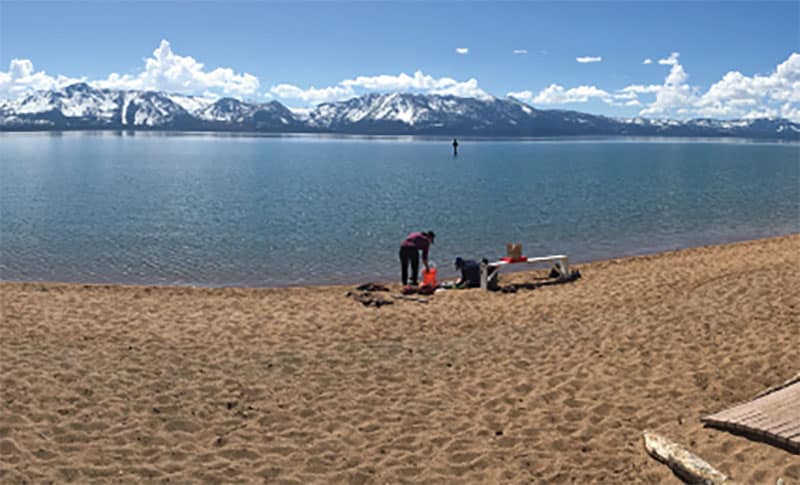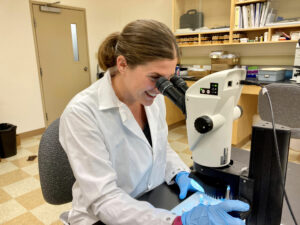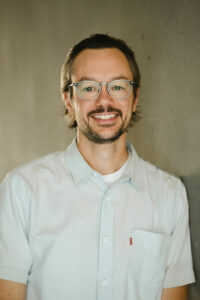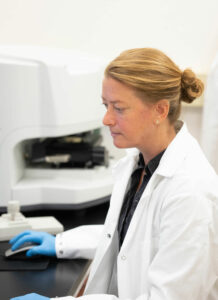Our Team
Monica Arienzo, PhD (she/her)

Monica Arienzo is an Associate Research Professor in the Division of Hydrologic Sciences at the Desert Research Institute. After years of studying caves in the Bahamas and ice cores from Antarctica, now she leads the Microplastics and Environmental Chemistry Research Team. Her interests are developing novel chemical tools to answer important environmental questions. When she’s not in the lab, you can find her hiking, running, snowboarding, or playing ultimate Frisbee. You can learn more by visiting her DRI personnel page and her Google scholar link.
(775) 673-7693
monica.arienzo@dri.edu
Daniel Saftner, M.Sc. (he/him)

Daniel Saftner is an Assistant Research Hydrogeologist in the Division of Hydrologic Sciences at the Desert Research Institute. His research focuses on developing hydrologic tools, tests, and models that help rural communities prepare for and respond to issues surrounding water resources sustainability and environmental health. Dan’s experiences as a Peace Corps Volunteer and Fulbrighter in Africa continue to inspire him to use his background in hydrogeology to serve disadvantaged populations. Dan enjoys travel, live music, skiing, softball, and camping in the desert with his partner and pup.
(775) 673-7422
daniel.saftner@dri.edu
Meghan Collins, M.Sc. (she/her)

Meghan Collins is an Associate Research Scientist, Environmental Science and Education Program Manager. She works to expand experiential learning and career-based STEM opportunities and translate the valuable results of DRI science to our communities.
Meghan.Collins@dri.edu
Graduate Students:
Rachel Kozloski

Rachel Kozloski is a PhD student in UNR’s Graduate Program of Hydrologic Sciences. Prior to beginning her PhD, Rachel worked in the private and government sectors as a soil scientist and environmental analyst. Her research focuses on microplastics in urban runoff and microplastic movement in connected surface and groundwater systems. When she is not conducting lab analyses or doing fieldwork she is equally happy exploring wild places or curled up with her dogs and a good book.
Hannah Lukasik

Hannah Lukasik is a M.S. student in UNR’s Hydrologic Sciences Program. Her work includes studying microplastic concentrations in the Lower Colorado River compared to the Truckee River. She is passionate about clean drinking water and any contaminant that could negatively impact water quality. Originally from Wisconsin, she is excited to be in the presence of mountains and loves to spend her time outside biking, swimming, and kayaking or doing anything that allows her to be creative and curious.
Kerri Minatre, M.Sc.

Kerri Minatre is a PhD student in UNR’s Ecology, Evolution, and Conservation Biology program. Her research focuses on using charcoal properties to infer properties of fire and associated ecological effects on ecosystems. She uses her background in archaeology, soil sciences, and fire ecology to inform her work. When she is not conducting lab analyses or doing fieldwork she enjoys trail running with her cattle dogs, camping, and working on her small urban farm.
Undergraduates/Technicians:
Angelique DePauw (she/her)

Angelique DePauw is an undergraduate student at the University of Nevada, Reno and is originally from Los Osos, California. She is working to complete her B.S. degree in Hydrogeology. When she is not conducting lab analyses, she enjoys working in her garden, trying out new recipes, and hiking and camping.
Helen Lei

Helen is an undergraduate student in the Integrated Elementary Teaching program, pursuing a bachelor’s degree in Elementary Education and minoring in Environmental Science. Her future goals are driven by her interests in water quality and environmental sustainability, with focus on watershed protection. In her free time, you can find her at home cooking up a new dish, playing with her cats, and rewatching her favorite shows
Luisa Ortega

Luisa completed her B.S. degree in Environmental Science with an emphasis in Ecological Conservation and Restoration. Her research in the Microplastics and Environmental Chemistry Laboratory explored using citizen scientists to collect samples for microplastic monitoring in collaboration with the League to Save Lake Tahoe’s
Alums:
Julia Davidson
Julia is an undergraduate student at the University of Nevada Reno. She completed her B.S. degrees in Chemistry and Education. In the Microplastics and Environmental Chemistry Laboratory, she explored plastic pollution in Lake Tahoe, in collaboration with Clean Up the Lake.
Erika Robtoy

Erika Robtoy is an undergraduate student at the University of Nevada Reno and is originally from Sparks, NV. She is working to complete her B.S. degree in Hydrogeology. Her current research in the Microplastics and Environmental Chemistry Laboratory explores metal contamination in private drinking water wells in Nevada. When she is not conducting lab analyses she enjoys trail running, rock climbing, and skiing.



 s that will improve on existing approaches by increasing the ease of sample collection and analysis, advancing data quality, and establishing standardization guidelines to facilitate microplastic pollution comparisons between studies. Funding is provided by the National Science Foundation. Link to publication.
s that will improve on existing approaches by increasing the ease of sample collection and analysis, advancing data quality, and establishing standardization guidelines to facilitate microplastic pollution comparisons between studies. Funding is provided by the National Science Foundation. Link to publication. 
















